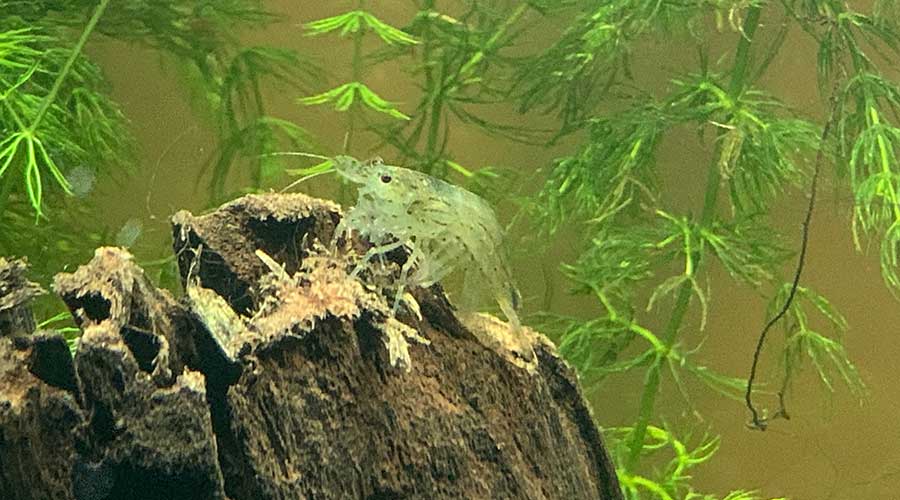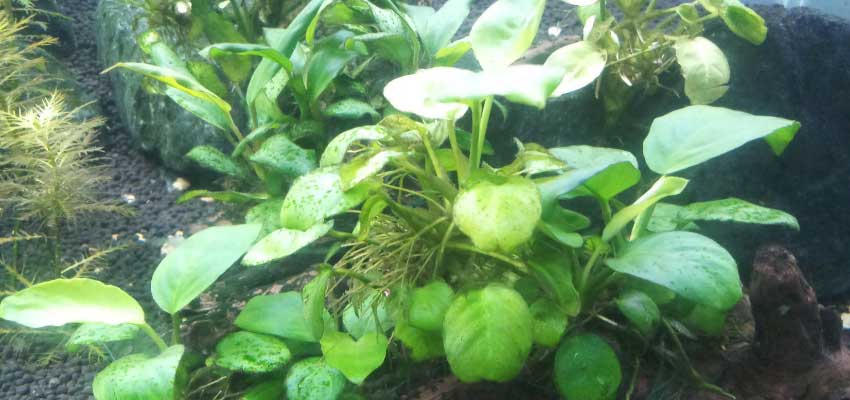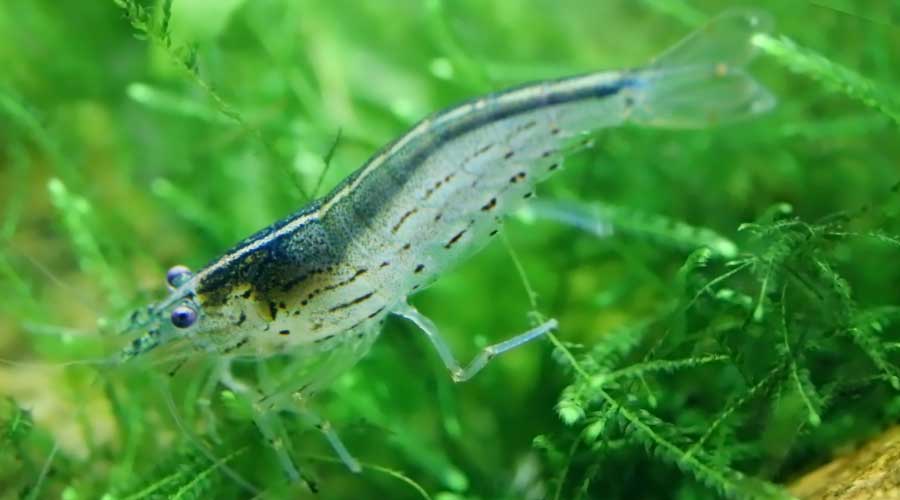In this blog, we’ll talk about shrimp for tanks, specifically, community fish tanks. Although many shrimp, like bee shrimp, need a lower pH and require stricter water parameters, Amano shrimp water requirements make them a great choice for some community tanks, among other reasons. Below, we’ll look at Amano shrimp and Amano shrimp care.
| Amano Shrimp | |
|---|---|
| Origin: | Asia |
| Lifespan: | 2 to 3 years |
| Size full grown: | 2 to 3 inches |
| pH requirements: | 6.5 to 8.0 |
| Water temperature: | 70 to 80 degrees |
| Temperament: | Mostly peaceful |
| Minimum Tank Size: | 10-gallons recommended |
Shrimp for Tanks: Amano Shrimp May be Perfect for Your Community Tank
Amano shrimps (Caridina multidentate) are light in color, almost see-through really. Most Amano shrimps are light gray or light brown with bodies that have dots running down their bodies longways.
I’ve successfully kept Amano shrimp in one of my tanks with other community fish. These guys are a hoot, too and fun to watch when you have the chance.
When I first got my Amano shrimp for my tank, I thought these guys would disappear to eat algae and only surface every so often. While my Amano shrimp do stay hidden in my driftwood a good bit of the time, they will come out sometimes to pick up a sinking algae pellet.
What’s so interesting about these guys is how they swim through the water and scale the glass walls of my fish tank.
One of the reasons why these guys are good shrimp for tanks is because they can have varying water parameters that are comfortable for a lot of freshwater fish.
Let’s take a closer look below.

Origin of Amano Shrimp
Amano shrimp are indigenous to parts of Asia. They can be found in Japan, China, and Taiwan in freshwater rivers and streams.
Tank Size for Amano Shrimp
If you plan on keeping Amano shrimp, you’ll want at least a 10-gallon fish tank. As far as the number of these shrimp that you can keep in a 10-gallon tank, you’ll read various opinions.
Some keepers say five shrimp to a 10-gallon tank while others say that you can keep one to two shrimp per gallon of water. Even though these guys don’t have a significant bioload, I still like to play it safe and stick to one per two gallons of water. But, that’s just my personal preference. Remember, you’ll also have to consider the other fish you plan to keep or are keeping in your tank.
Water Parameters
The water parameters for Amano shrimp are one of the reasons that Amanos are such great shrimp for community tanks with other freshwater fish. Unlike bee shrimp and others, these guys can do well in water parameters that also work for many different types of freshwater fish.
Amano shrimp should be kept in water with a pH of 6.7 to 8 with water temperatures of 70 to 80 degrees. So, you have some room to play with. And again, these water conditions are great for other types of freshwater fish.
Substrate
For substrate, I’d suggest small gravel to sand. Either will work just fine. Personally, I prefer black sand.
Shrimp for Tanks: Plants

Like most shrimp, Amano shrimp do well with live plants. There are some easy-to-care-for live plants that you can keep in community tanks that will work great with Amano shrimp.
Plants like Java moss, Anubias, and water wisteria will work well. Amano shrimp like to hideout in plants and also jump around the plants. And, it’s worth noting, these guys can seriously jump. So be careful, they are also some great escape artists.
Plants for Amano Shrimp:
- Java Moss
- Java Fern
- Anubias
- Water Wisteria
Acclimating Shrimp for the Tank
Like with any other aquatic life, you don’t want to simply dump shrimp directly into the tank after you bring them home. You need to properly acclimate them so you don’t stress them out.
The way I acclimate my Amano shrimp is by taking the bag they were placed in at the store and setting it in the water of the fish tank. I will let the bag sit there for 20 minutes. Then, I will add a little bit of tank water into the bag every few minutes before letting them free from the bag. This seems to do the trick for my Amanos.
Temperament: Why Amanos are Great Shrimp for Tanks
The temperament of Amano shrimp is for the most part peaceful. These guys do spend a lot of time handing out under driftwood, in crevices of driftwood, and in plants.
However, when it comes to feeding these little guys, it’s not uncommon to see them come out of nowhere to pounce on a sinking algae pellet. But, as far as them being aggressive towards other fish, I’ve never seen it happen. These guys are bigger than other shrimp, like bee shrimp, but they are still quite small and friendly in most tank settings.
Feeding Your Shrimp
As noted above, Amanos can be fed sinking algae pellets. But, they also eat dead plant matter in the tank.
A major benefit of Amano shrimp is that they can act as a cleaning crew for your aquarium. These guys do a very good job at eating algae in the tank, which is a good thing.
Tankmates for Amano Shrimp
I keep my Amano shrimp in a 36-gallon aquarium with electric blue rams, German blue rams, and emerald green corydoras. The rams are dwarf cichlids that are very peaceful while the corydoras are peaceful and playful.
Although this setup works well, sometimes, when Amano shrimps mate and have baby shrimp, the babies are likely to get eaten. However, breeding Amano shrimp can be challenging in the first place.
Tank Mates for Amano Shrimp:
- Electric Blue Rams
- German Blue Rams
- Corydoras
- Tetras
Recap: The Perfect Shrimp for Tanks
If you are looking for some cool shrimp to keep in your community tank, Amano shrimps can be a great choice. These guys are interesting, peaceful, and do a great job at cleaning up decaying plant matter and algae. This is, of course, great for the health of your tank.
Remember, it’s important to keep Amano shrimp in at least a 10-gallon fish tank with live plants. You can feed these little guys sinking algae pellets and they can do well in tanks with peaceful fish such as blue rams, corydoras, and tetras.
Our Recommendations

